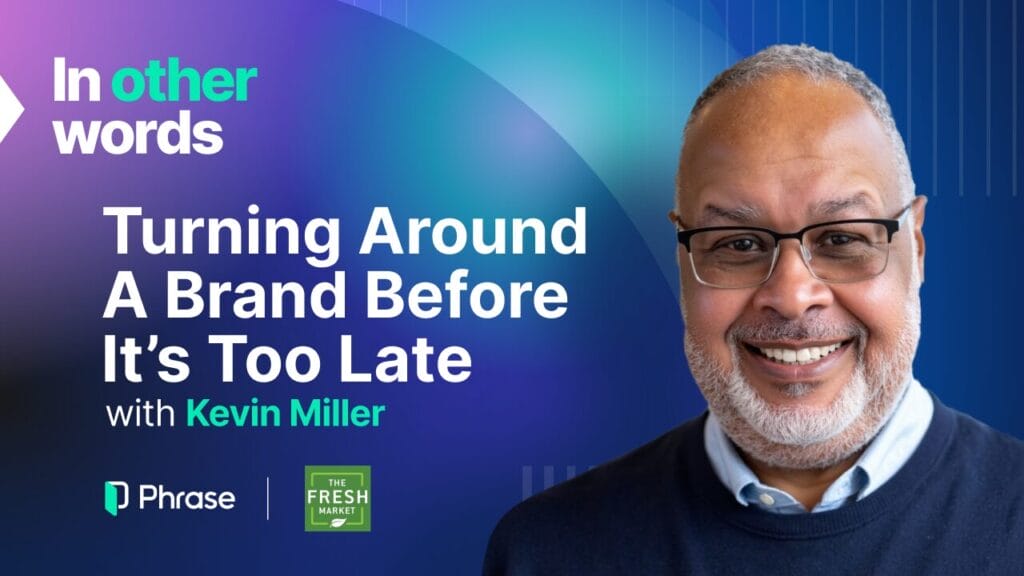Executive summary
For Annette Franz, founder and CEO of CX Journey Inc., customer experience goes beyond being just a department. It’s a key part of business culture. Speaking with Phrase CEO Georg Ell and host Jason Hemingway on our In other words podcast, Annette explains why culture must function as the “operating system” of any organization that aims to connect employee and customer experiences at a global scale.
The most successful leaders, she argues, treat culture as a deliberate design choice, built on core values, lived behaviors, and constant feedback loops. Aligning leadership, embedding local nuance, and codifying non-negotiables enables organizations to scale culture without diluting authenticity.
For Annette, the link between employee and customer experience is inseparable:
“Culture is the foundation. Fix the culture, fix the outcomes. It really is the operating system of the business. If the operating system is broken, everything else runs badly.”
– Annette Franz, Founder and CEO, CX Journey
In this multifaceted discussion, our guests both agreed that trust, context, and communication form the connective tissue of global culture. Technology and AI can remove friction, but humanity keeps meaning intact.
In an era of distributed teams and rising expectations, Annette offers a simple culture focused framework that leads to powerful outcomes: engaged employees, loyal customers, and businesses that thrive everywhere they operate.
From market research to movement building
Annette Franz didn’t set out to become one of the world’s most respected voices in customer experience. Her journey began at J.D. Power & Associates in the early 1990s, where a love of math, writing, and data turned into a passion for understanding how businesses could improve both employee and customer outcomes.
Over three decades across leading voice-of-the-customer platforms, corporate roles, and now her own consultancy, Annette has seen CX evolve from a functional practice into a strategic imperative.
“What we do is about and for customers,” she explained. “Without customers, we don’t have a business.”
That shift, she said, demands leadership commitment, cultural alignment, and above all, a recognition that employee experience drives customer experience.
Culture as the foundation and operating system
When asked what organizations should focus on first, Annette doesn’t hesitate: “Culture, culture, culture.”
For leaders, this means defining core values and operationalizing them across every process: how the company hires, promotes, reviews performance, makes decisions, and rewards behavior. Culture isn’t just words on a wall. It needs to be action in motion.
Georg Ell agreed, emphasizing that leadership must model the behavior they expect. “Live it, don’t laminate it,” he said. “People can sense authenticity, even when they’re not in the room.”
Local nuance, global consistency
Scaling culture globally introduces new complexity. Annette advocates for a structured yet flexible approach: a culture plan that defines shared values but allows for local interpretation.
“Things that make sense in the U.S. might not in Germany or Japan,” she noted. “Culture has to be localized, otherwise meaning gets lost in translation.”
Her model relies on culture ambassadors. Local champions who live and promote values within their regions. These teams maintain consistency while adapting to local expectations. Governance structures, culture committees, and clear measurement help organizations understand whether values are truly being lived.
For Georg, this is where leadership signaling matters. Recalling his time at Microsoft, he pointed to the shift under Satya Nadella: “Leaders started embracing diversity, even visibly, by allowing employees to use non-Microsoft devices. It was a small thing that signaled a big cultural shift.”
Measuring meaning: feedback loops that work
Both guests emphasized that culture can’t thrive without feedback. Annette outlined how employee listening should mirror customer listening with frequent, actionable, and transparent loops.
“It doesn’t have to be massive surveys,” she said. “Pulse checks, stay interviews, listening tours… the point is to ask, acknowledge, and act.”
Georg also shared how Phrase implements this philosophy: weekly all-hands meetings with anonymous Q&A, plus quarterly engagement surveys where participation exceeds 85%. Transparency, he said, builds trust.
Annette agreed but warned against over-surveying without action: “If you’re going to ask quarterly, you’d better be able to make changes and fast and show employees what you did. Otherwise, people stop believing the process matters.”
When resistance meets resilience
Transformation inevitably meets resistance. Annette distinguishes between those unwilling to change and those uncertain about it.
“Some people just won’t get on the bus,” she said. “But others can be brought along through education, communication, and consistency. They need to understand the why, the how, and the when, and see progress along the way.”
Georg added that vulnerability and context are critical leadership tools: “Transparency builds credibility. When teams see you answer hard questions honestly, it deepens trust.”
AI, humanity, and the meaning of work
Both leaders see AI as an enabler, but only when it amplifies humanity.
“We should use AI to automate friction, not relationships,” Annette said. “Keep the human part human.”
Georg echoed the sentiment:
“We should use AI to enhance our humanity, not to deprecate it. It can help us articulate values in ways that resonate locally, but it can’t define meaning for us.”
– Georg Ell, CEO, Phrase
The business case for culture
Annette connects the dots between culture, employee experience, customer loyalty, and business outcomes through a simple chain reaction:
- A strong culture builds engaged employees.
- Engaged employees create better customer experiences.
- Satisfied customers drive loyalty, advocacy, and growth.
“It’s a competitive advantage. When you design the culture deliberately and support employees, the results cascade all the way to the bottom line.”
– Annette Franz, Founder and CEO, CX Journey
Georg summed up the leadership implication: “You can’t separate employee experience from customer experience. They’re one system and culture is what connects them.”
Closing reflections
In a global business landscape defined by speed, technology, and complexity, both leaders came back to one constant: culture as the foundation for everything else.
As Annette put it, “We talk a lot about global strategy, but it has to be localized. There has to be that local voice built in.”
Her advice for leaders was clear: start with culture, listen deeply, lead consistently, and remember that people (not processes) define the experience.
In other words, fix the culture, and you fix the outcomes.
Hear more
If you’ve enjoyed this look at the highlights from the latest episode of In other words, you can hear the entire episode now on our website, or subscribe via Spotify, Apple, or wherever you listen to your favorite podcasts.






